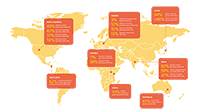
The most comprehensive long-term monitoring data for birds come from Europe and North America, where surveys started around 50 years ago. These data reveal significant declines in certain groups of birds, such as grassland/farmland specialists and long-distance migrants. Data on long-term trends in bird abundance are much scarcer in other parts of the world, but there is increasing evidence that population declines are occurring around the globe. Recent reports have highlighted declines in resident, insectivorous and specialised species in the agricultural countryside of Costa Rica. In Kenya, 19 of 22 raptor species have declined since the 1970s, while Uganda’s forest and savannah specialist species have also suffered declines. Citizen science is helping to fill data gaps in some countries, revealing declines in grassland/shrub, forest and wetland specialists in India and seabirds off south-eastern Australia.
Long-term monitoring data provide valuable insights into the trends in abundance of groups of bird species over time. The comprehensiveness of such data varies across the globe, with significantly more data available for temperate regions. In North America, for example, the North American Breeding Bird Survey has been running since 1966, providing over 50 years of bird population data, while in Europe the Pan-European Common Bird Monitoring Scheme brings together data from national monitoring schemes to produce population trends and indicators for the last 40 years. These data reveal significant declines in certain groups of birds – for example Europe’s common farmland birds have declined by 57% since 1980 (PECBMS 2021), while North American grassland specialists have declined by 42% since 1968 (NABBS data, courtesy of John Sauer, USGS Patuxent Wildlife Research Center).

Long-term trend data on bird abundance are much scarcer in other parts of the world, but there is increasing evidence that population declines are occurring worldwide. A twelve-year study in Costa Rica’s human-dominated agricultural countryside found that 62% of bird populations declined over the study period, with most of these declines occurring in more specialised, sedentary and/or insectivorous species (Şekercioğlu et al. 2019). In Africa, recently-established monitoring schemes in Uganda have already revealed declines of 39% in forest specialists during 2009-2015 (Wotton et al. 2020), while repeated road surveys in Kenya show that 19 out of 22 raptor species have declined since the 1970s, by a median of 70% (Ogada et al. 2022). Citizen science data is helping to fill data gaps in some countries. For example, analysis of data from the eBird platform suggests that in India, specialist species in forest, grassland/shrub and wetland habitat have all declined significantly since 2000 (SoIB 2020), while a citizen science dataset of pelagic seabird abundance off south-eastern Australia shows that 43% of abundant species declined during 2000-2016 (Gorta et al. 2019). Where long-term monitoring data are not available, population trends may be estimated using historical land cover maps and species distribution modelling. Using this method for the Ishikari Lowland in Hokkaido, Japan, one recent study estimated that the abundance of wetland bird species has declined by more than 88% since 1850, while the abundance of forest species may have declined by as much as 94% (Kitazawa et al. 2022).
References
Gorta, S. B. Z., Smith, J. A., Everett, J. D., Kingsford, R. T., Cornwell, W. K., Suthers, I. M., Epstein, H., McGovern, R., McLachlan, G., Roderick, M., Smith, L., Williams, D. & Callaghan, C. T. Pelagic citizen science data reveal declines of seabirds off south-eastern Australia. Biol. Conserv. 235: 226-235
Kitazawa, M., Yamaura, Y., Senzaki, M., Hanioka, M., Ohashi, H., Oguro, M., Matsui, T. & Nakamura, F. (2022) Quantifying the impacts of 166 years of land cover change on lowland bird communities. Proc. Royal Soc. B. 289: 20220338
Lehikoinen, A., Brotons, L., Calladine, J., Campedelli, T., Escandell, V., Flousek, J., Grueneberg, C., Haas, F., Harris, S., Herrando, S., Husby, M., Jiguet, F., Kålås, J. A., Lindström, A., Lorrillière, R., Molina, B., Pladevall, C., Calvi, G., Sattler, T., Schmid, H., Sirkiä, P. M., Teufelbauer, N. & Trautmann, S. (2019) Declining population trends of European mountain birds. Glob. Change Biol. 25(2): 577-588
Ogada, D., Virani, M. Z., Thiollay, J. M., Kendall, C. J., Thomsett, S., Odino, M., Kapila, S., Patel, T., Wairasho, P., Dunn, L. & Shaw, P. (2022) Evidence of widespread declines in Kenya's raptor populations over a 40-year period. Biol. Conserv. 266: 109361
PECBMS (2021) European Common Bird Indicators, 2021 update. Available at https://pecbms.info/europeanwild-bird-indicators-2021-update
Şekercioğlu, Ç. H., Mendenhall, C. D., Oviedo-Brenes, F., Horns, J. J., Ehrlich, P. R. & Daily, G. C. (2019) Long-term declines in bird populations in tropical agricultural countryside. PNAS 116(20): 9903-9912
SoIB (2020) State of India’s Birds, 2020: Range, trends and conservation status. The SoIB Partnership
Stanton, R. L., Morrissey, C. A. & Clark, R. G. (2018) Analysis of trends and agricultural drivers of farmland bird declines in North America: A review. Agric. Ecosyst. Environ. 254: 244-254
Wotton, S., Eaton, M., Sheehan, D., Munyekenye, F., Burfield, I., Butchart, S., Moleofi, K., Nalwanga-Wabwire, D., Ndang’ang’a, P.K., Pomeroy, D., Senyatso, K. J. & Gregory, R. (2020) Developing biodiversity indicators for African birds. Oryx 54(1): 62-73
Compiled: 2022 Last updated: 2022
Recommended Citation:
BirdLife International (2022)
Birds are in decline across the globe.
Downloaded from https://datazone.birdlife.org/sowb/casestudy/birds_are_in_decline_across_the_globe on 22/12/2024